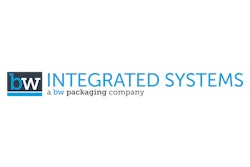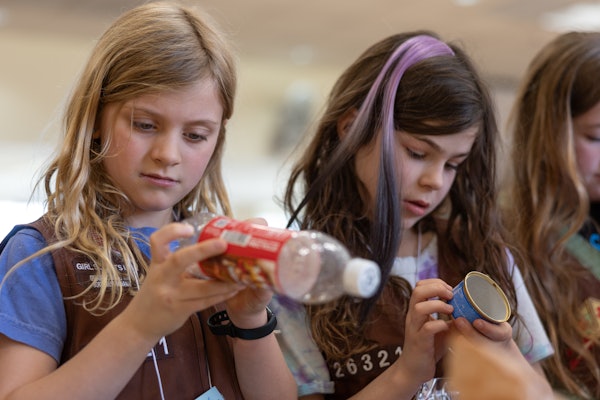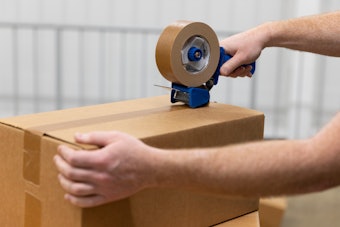
Well-known in its headquarters city of Philadelphia and throughout most of the northeastern U.S., Tasty Baking is now investing some $25 million over three years in a bid to nationally distribute its snack cakes. To accomplish that out of a single plant, productivity and efficiency had to be improved. That meant investing in automation for much of the packaging equipment at Tasty's 82-year-old six-story factory in the City of Brotherly Love.
First in line for modernization was the sixth floor, where four ovens are dedicated to producing Krimpets and Junior cakes. In the past, these snacks were hand-fed into flowrappers. Cartoning was automated, but case packing was another manual operation.
In December, that changed dramatically. The firm gutted the entire floor and reassembled it with automatic equipment, including three bottom-loading case packers from Salwasser (Reedley, CA).
"We looked at all the case packing equipment out there," says director of production Tom Kenney. "We needed case packers that could flat-out run fast, without any limitations. That meant considering not only throughput, but good product handling, machine durability and quick changeover. We had the highest level of confidence in the Salwasser technology."
Salwasser's bottom-loading case-packing systems accumulate and vertically load cartons into corrugated cases. Because the process is gentle it allows cartons of the fragile cakes baked by Tasty to be case packed efficiently yet with minimal product handling and damage.
Each Salwasser system at Tasty Baking also features a unique loading tube that actually shrouds the cartons of product and is lifted slightly into the empty case just before product is lifted into the case. This technology eliminates the problems associated with the edges of cartons catching on the edges of cases. "Salwasser's carton shrouding system offers positive control," explains plant superintendent Joe Carboy. "Reducing product jams, this system improves efficiencies."
Automating the case-packing operation also brought tremendous benefits in the way people are deployed.
"We previously had six people case packing Krimpets and Juniors on the four packaging lines," says Kenney. There were five packers and one monitor. "We managed to redeploy four of these people to other parts of the plant. Now case packing is handled by only two operators. As we progress on our learning curve with this new technology, we'd like to handle this operation with one person."
Representative line
Upstream from the case packers, other key improvements were made on all four packaging lines that occupy the floor. Line 64, dedicated to Junior cakes in a variety of flavors, provides a good illustration of what each modernized line looks like.
The Junior cakes leave the oven eight-across on a metal belt conveyor that takes them to a transfer conveyor leading to the packaging equipment. A row aligner, supplied by Delta Systems (Rogers, AR), makes sure all eight cakes are lined up evenly. The aligner is simply a pneumatically driven plastic blade that comes up in the gap between two conveyor sections to stop the cakes for a split second. If one cake is lagging, it has a chance to catch up before the blade sinks.
Once aligned, the row of cakes leaves the transfer conveyor and proceeds ahead to the first of two Delta Systems transpositor belts. These retractable belts are designed to stroke back quickly, like the table cloth being pulled from beneath the dishes, thus creating a gap through which all eight cakes drop onto a takeaway conveyor running at a right angle. The transpositor then strokes back to its home position so the next row of eight cakes is conveyed right over it to the second transpositor belt. It drops its eight cakes onto a second takeaway conveyor running parallel to the first.
The use of two transpositor belts makes it possible to feed two Delta Systems flowrappers from one oven discharge conveyor. Just ahead of each flowrapper is a smart-belt infeed system, also from Delta Systems, that consists of five conveyor segments each driven by its own servo motor. The system serves two important purposes. First, the differential speeds of its first two conveyor segments turns each cake 90° so that cakes are aligned end-to-end in a single file. Its remaining conveyor belt segments create consistent spacing between cakes. Photoeyes detect the location of each cake, signalling the system's industrial PC to speed up or slow down individual belt conveyor sections as needed. In this way, each cake is properly aligned for placement into a flight of the flowrapper.
Longer shelf life
The Delta Systems flowrappers wrap each cake in a 85-ga film supplied by Mobil Chemical (Pittsford, NY). The wrappers create a fin-seal bottom and heat-sealed front and back on each cake package. A photoeye from Sick (Bloomington, MN) looks for eye marks on the edge of the film to keep the printed wrap in register.
The 85Bicor®AXT film is a three-layer coextrusion with an acrylic coating on one side and a coating of polyvinylidene chloride for oxygen barrier on the other side. The core of the three-layer coextrusion is oriented polypropylene, which is sandwiched between what Mobil calls "adhesion-promoting layers."
Since adopting this film just before the sixth-floor modernization, Tasty Baking was able to increase product shelf life from 10 to 21 days. That's important to a bakery with national distribution as a goal.
Emerging from the side-by-side flowrappers, the cakes are conveyed toward a continuous-motion cartoner, the Paragon Model 750 from MGS Machine (Maple Grove, MN). Its function is to collect six wrapped cakes, three on top of three, in its infeed buckets, erect a carton blank, load all six cakes into the carton and close the carton. It does all this despite a relatively small footprint: 11'x3'4", excluding the infeed conveyor.
"We really wanted a continuous-motion cartoner," says Kenney. "It gives us a steady 50 cartons a minute. It's capable of more, but that's just where we are with it."
Resembles a tank tread
The cartoner's infeed buckets are mounted on a track whose motion resembles that of a tank tread. In other words, its 50 buckets move continuously forward in an eliptical path. Along that path, each bucket receives cakes, has cakes pushed from it and into a carton, and then continues its elliptical path until it pops up for another load of cakes.
According to Kenney, the cartoner design solves a number of problems. "The major innovation is in the way the cakes are assembled in that six-count configuration and then pushed into the cartons," says Kenney. Carton board is 18-pt clay-coated newsback printed offset in two colors.
Two overhead sweeps, each fed by one upstream flowrapper, perform the task of sweeping cakes three at a time from two collating stations and into the cartoner's infeed buckets. The second sweep, located a few feet downstream from the first, sweeps its three cakes on top of the first three.
Here's how it works. As the third cake nears its collating station, a photocell signals the system's PLC, which in turn signals an upstream gating system to gently close on the flow of cakes. Once the collating station receives its third cake, another photocell signals the servo motor of the overhead sweep to push the cakes out of the collating station, causing them to drop directly into the infeed bucket below. Upstream, the gate is released to allow more cakes to move forward into the collating station. Meanwhile, the cakes that have been swept into the infeed bucket are pushed by a barrel cam loader into an erected carton. Flaps are tucked and glued closed, and the finished carton is conveyed out.
Watching the overhead sweeps operate is like watching two miniature ferris wheels in action. But instead of holding passenger cars at the end of each spoke, these ferris wheels hold six flat paddles that sweep wrapped cakes from the collating station into infeed buckets at the command of the PLC.
According to Kenney, the size of a Junior Coffee Cake is not the same as that of a Junior Chocolate Cake, so carton sizes must change accordingly. Fortunately, he adds, the cartoner takes just 10 minutes to change, as Kevin Kennedy of MGS explains.
Drop-in components
"We gave the machine drop-in components," says Kennedy. "Instead of adjusting individual plows and guides and the glue/tuck assembly, you just loosen a series of handles to remove the assembly and drop in another one. Tighten the handles and your changeover is done."
Case packing is next. On Line 64, it's done 12 cartons/case and five cases/min on a single-infeed Salwasser machine, a Model R101/B-80. Top speed of the case packer, notes Salwasser, is 12 cases/min.
Space constraints make overhead conveying the only practical way to transfer cartons of Junior cakes to the case packer. So overhead conveyors from FlexLink Systems (Bethlehem, PA) were installed for that purpose.
At the Salwasser case packer, as each case blank is indexed into position for opening, a set of two vacuum cups adheres to the flaps of the case. A blade is quickly inserted into the case, breaking the case scores and assisting in positive case opening. A third and larger vacuum cup adheres to the front of the blank and pulls the case open.
On one of the four packaging lines on the sixth floor, changeovers are frequent, so on that line the quick-change capabilities of the Salwasser case packer come in handy.
"In our experience with other equipment, taking an hour to change over is not unusual," says Carboy. "But the Salwasser machines have PLC controls that allow varying package parameters to be preprogrammed into memory. The PLC automatically controls 95 percent of the changes that need to be made. It takes one operator about 10 minutes to complete a changeover."
Tight squeeze
Fitting modern technology into Tasty Baking's sixth floor was a challenge. Severe space constraints and the need to maximize production throughput were in conflict. When it was determined that Salwasser's standard case packers wouldn't fit, Salwasser began the process of custom-engineering the machines to accommodate the available space. The case-feeding magazine, for instance, was repositioned, and the case transfer drive was modified as well, all in an effort to shrink the overall footprint.
"Salwasser worked with us, making joint manufacturing decisions with us to change their technology to meet our product goals and fit into our space," says Carboy.
While line 64 has a single-infeed Salwasser machine, nearby is the Model R-122/B-80 with two independent infeeds. Two MGS cartoners feed this machine. The independent infeeds stack and index cartons onto a common load plate, permitting the case packer to run even if one of the cartoners stops. All three of the new Salwasser machines on the floor load cartons into RSCs and seal the cases closed with hot melt adhesive units from Nordson (Duluth, GA).
Even though the plant modernization has a long way to go overall, having the sixth floor finished is obviously a big relief to all who worked on it. The new equipment has brought production capacity that makes national distribution a reality.
"From the time we shut down the operation to the time we restarted, it took 21 days," says Kenney. "That includes gutting the entire floor, painting, cleaning, piping and wiring."
That doesn't mean the company stopped selling Juniors and Krimpets. "We froze product for three weeks before the shutdown to build up a buffer," says Kenney. "And we did the work over the Christmas holidays when volume is at its lowest."
Still, the pressure was on. "It was absolutely imperative that we have the floor back up in operation after 21 days," says Kenney. "And we did."
































